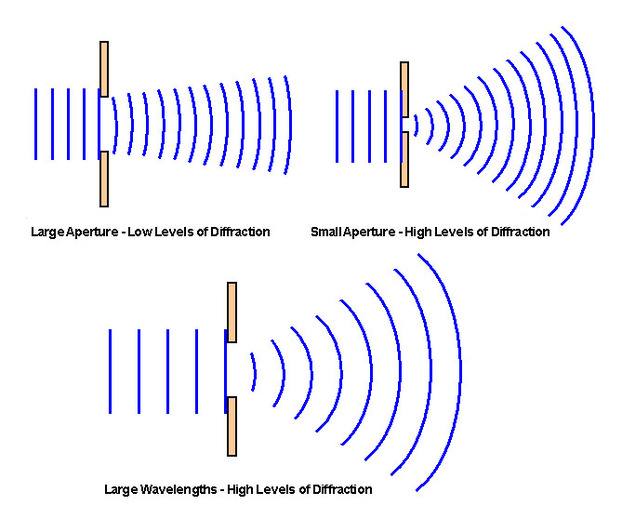Ngā Whāinga Ako 🔗
- Explain the interference of two wave patterns in terms of nodes, anti-nodes and path difference
Diffraction 🔗
- When waves pass through an opening or bump against a barrier, they will diffract
- Openings: The most diffraction occurs when the opening width and wavelength are similar

🔗
- Barriers: Longer wavelengths diffract best around barriers e.g. AM radio has a longer wavelength than FM and can be better heard in the mountains
- Notice that the wavelength does not change when diffraction occurs.

Constructive vs Destructive Interference 🔗
- Recall the following:
- In phase waves constructively interfere
- Out of phase (180deg) waves destructively interfere
- Waves not exactly (180deg) out of phase partially interfere

Two Point Source Interference 🔗
- Two point sources with the same frequency and amplitude are placed near each other
- Their waves will interfere to create points of zero amplitude, and points of 2x amplitude of the original wave

Interference of Light 🔗
- For light to interfere we need:
- Waves of the same frequency
- Waves with the same amplitude
- Waves with a stable phase relationship (coherent)
- This is usually achieved by passing light from a single source through two very narrow and close slits.

Path Difference 🔗
- Moving away from the centre point, the distance each travels becomes unequal
- This means the waves will not keep a constant phase relationship
- We call the difference in the distances that they travel the path difference

Worksheet 🔗
- Collect a worksheet
- Fill out the table by counting the number of wavelengths to each point
- Use the table to determine the path difference for each of the anti-nodal lines
- Highlight the statements in the two boxes on the second page
- Finish the rest of the questions on the sheet
Calculating Path Difference 🔗
- Path difference can be written as $pd$
- Antinodal Lines: $pd = n\lambda$
- Nodal Lines: $pd = (n - \frac{1}{2})\lambda$

Mahi Tuatahi 🔗

- If you used the equations, verify by counting wavelengths on the diagram.
- If you used the diagram, verify your answer by doing calculations.
Interference Formula 🔗

This assumption lets us formulate this equation which we can use to calculate a variety of things:
$$ \begin{aligned} pd &= \frac{dx}{L} \end{aligned} $$
pd = path difference
d = distance between the slits
x = distance of the fringe (bright spot) from the center
L = distance between slits and screen
What does it tell us? 🔗
$$ \begin{aligned} pd &= \frac{dx}{L} \newline \text{Rearranging for x and substiting $pd = n\lambda$:} \newline x &= \frac{n\lambda L}{d} \end{aligned} $$
- as wavelength ($\lambda$) increases, so does the fringe spacing (x)
- as screen distance (L) increases, so does the fringe spacing (x)
- as slit separation (d) increases, the fringe spacing decreases
Interference Formula 🔗
All this futzing leaves us with a series of formula:
$$ \begin{aligned} pd &= n\lambda \text{ antinodes} \newline pd &= (n- \frac{1}{2})\lambda \text{ nodes} \newline pd &= \frac{dx}{L} \newline \text{OR} \newline pd &= dsin(\theta) \newline &\text{ ^ assumes } \theta \approx \theta ' \end{aligned} $$
Practice 🔗
- Take some time to try the questions from Textbook Activity 4B
- Check your answers or find some help from the answers on Classroom